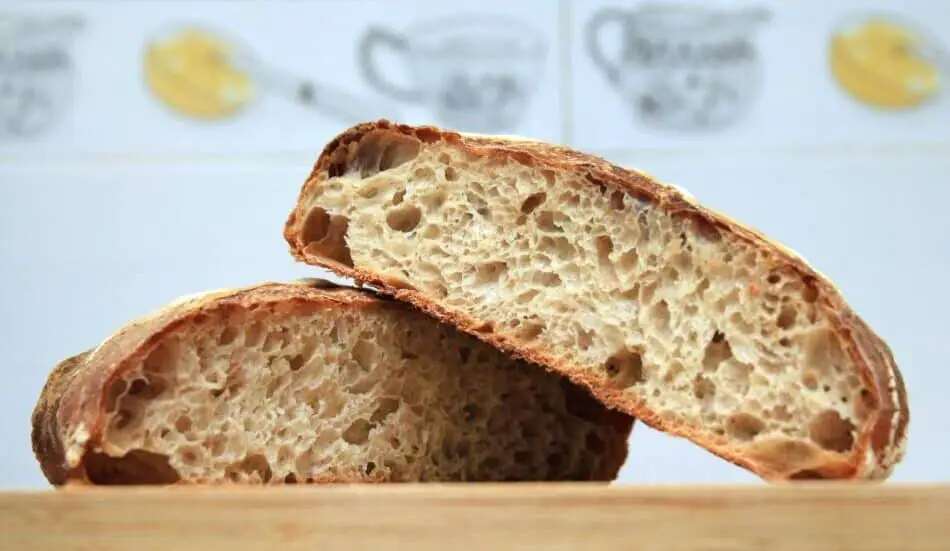There are two main differences in the ingredients and baking process between sourdough bread and regular bread.
- Sourdough bread is leavened by wild yeast and bacteria while regular bread is leavened by commercially cultivated yeast.
All breads requires a leavening agent, which is a healthy population of microbes that undergoes fermentation to transform the starches in the bread into alcohol and carbon dioxide gasses. The leavening and fermentation process is important for bread to rise, and for the crumb and crust to set.
The leavening agent of a sourdough bread is called a sourdough starter, which consists of only wild yeast and bacteria found naturally in the flour, and there is no commercially cultivated yeast added into the sourdough starter.
Regular bread however, consists of some wild yeast and bacteria, but its main leavening ability comes from the commercially cultivated yeast that was added to the dough.
- Sourdough bread is made with a pre-ferment while regular bread is not made using a pre-ferment.
Sourdough breads are leavened by the sourdough starter which has been left to ferment separately for 4-8 hours prior to being incorporated into the final dough mix, allowing the population of the wild yeast and bacteria in the sourdough starter to strengthen in quantity and vigor before it is used in the bake. Some of the flour used in the bake will have undergone fermentation twice.
Regular breads are leavened using commercially grown yeast, and we do not need to strengthen the yeast population prior to baking, hence the packaged yeast is added straight into the final dough mix and fermentation begins. All the flour used in the bake has undergone fermentation only once.
Some breads are made using commercial yeast and a pre-ferment, these are known as yeasted pre-ferments (aka poolish, biga, pate fermentee) . A mixture of flour, water and commercial yeast is left to ferment prior to being added into the final dough mix, very much like a sourdough starter; the difference is yeasted pre-ferments contains commercial yeast while sourdough starter does not.
Yeasted-prefermented breads rises better and has a more yeasty taste than sourdough bread. Sourdough bread has better keeping quality and a more complex sourness than yeasted pre-fermented breads.

Does sourdough starter have yeast?
Sourdough starter contains wild yeast, but not commercially grown yeast. The wild yeast in sourdough starter originates from the flour that is used in the feedings; no additional packaged yeast is added to a sourdough starter.
Is sourdough starter better than yeast?
| Attributes | Sourdough Starter | Commercial Yeast |
| Flavor | ✓ | |
| Dough Strength | ✓ | |
| Rise | ✓ | |
| Convenience | ✓ |
Breads leavened with sourdough starter is better than breads leavened with commercial yeast due to the presence of matured acid producing bacteria in sourdough starters.
As sourdough starters are maintained and developed over a few weeks, a complex range of lactic acid bacteria are allowed to strengthen in population and releases the acids that gives sourdough bread its distinctive sourness and complex flavor profile.
Regular breads leavened with commercial yeast does not have a high quantity of acidity as these lactic acid bacteria requires a long time to strengthen and grow in population; regular breads made with commercial yeast does not have sufficient fermentation time for acid production.
Breads leavened with sourdough starter has a more complex flavor profile than breads leavened with commercial yeast. Lactic acid bacteria produces lactic acid and acetic acid during fermentation. Acetic acid imparts a complex flavor profile to your bread but requires a very long fermentation time. Sourdough starters that have been continuously maintained over weeks produces much more acetic acid than breads leavened with commercial yeast, hence sourdough breads possesses a more complex flavor profile.
Dough made with sourdough starter is stronger than dough made with commercial yeast. The acidity released into the sourdough tightens gluten bonds, which strengthens the dough. Hence sourdough bread does not require as much mixing time as regular bread, and the stronger gluten bonds enable sourdoughs to hold its shape well from high hydration and high whole grain formulation.
Breads leavened with sourdough starter takes a longer time to rise than breads made with commercial yeast. However, breads made with sourdough starter can achieve the same rise as breads leavened with commercial yeast if we increase the duration of the bulk fermentation and final fermentation stages.
Baking with a sourdough starter requires more effort and is the less convenient option. The wild yeast and bacteria in the sourdough starter requires about 14 days to mature before the culture is strong enough to be used for baking sourdough bread for the first time. Once it has reached its peak maturity, the starter can be used everyday to leaven bread, but it has to be maintained through a daily ritual of discarding and feeding with flour and water.
The baker can only start baking when the sourdough starter has fully matured, which may sometimes take longer than expected, disrupting the baker’s schedule. Baking with commercial yeast however, the baking process can start whenever the baker is ready as the baker only needs to add water to the yeast and fermentation will start.

Can I add yeast to sourdough that didn’t rise?
Adding yeast to a sourdough’s dough that didn’t rise will be effective in producing a well risen dough if given sufficient fermentation time for the newly added yeast to strengthen in numbers. The dough is now no longer traditionally sourdough as commercial yeast has been introduced to the dough. The baked loaf will taste more yeasty than sour.
Adding yeast to sourdough starter that didn’t rise will be effective in causing the culture to rise. The culture however, is no longer a sourdough starter, but rather it has become a yeasted pre-ferment from the inclusion of commercial yeast. The microbial culture of the mixture now consists of predominantly commercial yeast as they will quickly overpower the weak wild yeast and bacteria population.
If the yeasted pre-ferment is maintained through daily discarding and feedings, the bacteria population will strengthen over time to produce the acidity and sourness known for in sourdough bread. The yeasted pre-fermented bread however, will still smell and taste rather yeasty compared to a traditional sourdough bread.
Conclusion
Sourdough breads made with sourdough starter is by far more delicious and superior than regular breads made with commercial yeast. However, baking with commercial yeast allows the baker to produce decent bread with minimal effort; the baker does not have to tend to the needs of the sourdough starter, and manage its day-to-day variabilities.
A great middle grown between the convenience of using commercial yeast and the flavor and texture superiority of sourdough starters is the use of yeasted pre-ferments. Commercial yeast is added to a mixture of flour and water that is separated from the final dough, and left to ferment for 12-16 hours at 20 Celcius. The fermented mixture of flour and water is then added to the final dough during mixing.
The long fermentation duration allows the bacteria population to strengthen to produce acids that imparts complex flavors, while the lack of using any sourdough starter means the baker does not have to feed and maintain the sourdough starter on a daily basis.
Breads made with yeasted pre-ferments will taste more yeasty and less sour than breads made with sourdough starter, but offers more convenience to the baker.


